Quick, somebody get Woody Allen on the phone, his next Jazz Age romance set in Paris has arrived, fresh as a croissant just out of the oven.
Opening scene: Spring 1926, nice Jewish girl from Brooklyn just off boat heads to Montmartre. Shares an outdoor table with painter named Pablo, whom she sketches (maybe juice the history a bit and have them draw each other). Scene two, teenage heroine studies color with Matisse and Cubism with Andre Lhote.
.
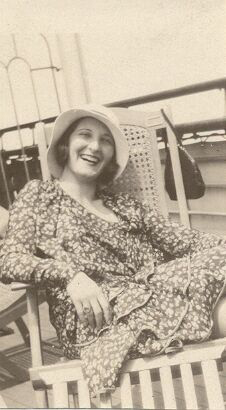
Anna Walinska on a ship to Paris. Courtesy of Lawrence Fine Art.
.
Later scenes are set on 57th Street in Manhattan (where she opens a gallery), on stage in the Yiddish theater and as a flamenco dancer, and a wild ’round-the-world trip with a four-month stay in Burma (where she becomes the court painter). Think “Pollock” meets “Anna and the King of Siam.” All Woody has to do to get the project started is drop in at the exhibition of Anna Walinska’s abstract paintings at Lawrence Fine Art in East Hampton, on view through August 30, 2015.
.
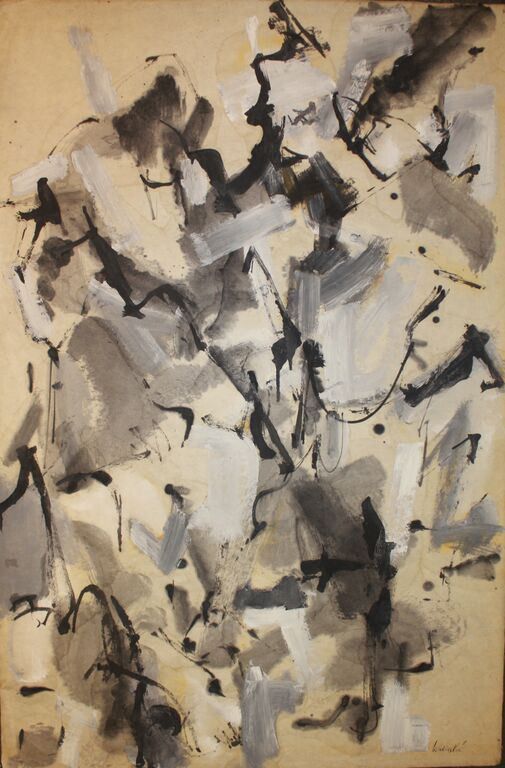
"Survivors" by Anna Walinska, 1953-56. oil & casein on paper, 44 x 29 inches.
.
Even before taking in the first work in this vigorously honest exhibition of painting, the biographical backstory is enchanting. Anna Walinska was the shy but determined daughter of a labor organizer and a poet in the fur trade. At the Art Students League in the early ’20s all she ever heard was that the action was in Paris, where Picasso had succeeded Lautrec as the dominant gravitational force, drawing painters from Asia, across Europe and the United States.
.

Anna Walinska. Photo taken in Paris. Courtesy of Lawrence Fine Art.
.
Her family could not afford the passage, so she made a deal with her father’s boss at the leather goods shop. She would copy a masterpiece in the Musee Luxembourg in exchange for the $2,000 she needed to spend a year in Paris. You have to love not just the chutzpah but the jackknife denouement: Returning with a creditable version of Paul Baudry’s La Fortune et Le Jeune Enfant, she so delighted her dad with the painting that he repaid the money to his boss and kept it.
Once in Paris at the absolute height of the Jazz Age, certainly one of the greatest confluences of artistic talent in history (it rivals the cultural heights of Periclean Athens, Renaissance Florence, Tang dynasty Chang’an, and fin-de-siecle Vienna), the 19-year-old Walinska made a beeline for the heart of Modernism. She lived on the Rue Madame and the Rue Stanislaus around the corner from Gertrude Stein and studied at the Academie de Grande Chaumier where she became a pupil of Andre Lhote.
A superb teacher if not the most revered of artists among his peers, his lessons in Cubism were unparalleled in authority and Walinska became an accomplished practitioner of the style. The importance of Cubism in her development will become evident in a moment, as the Abstract Expressionist work on view in East Hampton has its roots in this experience. Walinska was not exclusively a Cubist, as her niece Rosina Rubin pointed out in an interview just before the show opened. “My aunt was both a Picasso person and a Matisse person,” she said, “an artist of line and an artist of color, a Cubist and a realist. She did not believe in confining herself to one school.”
.
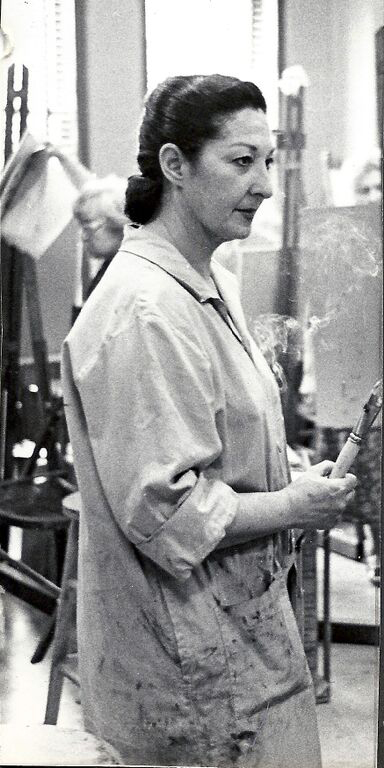
Anna Walinska in her studio. Courtesy of Lawrence Fine Art.
.
After the artist’s death in 1997, Rubin was in charge of organizing and cataloguing the art in the vast, eight-room apartment on the Upper West Side where Walinska had lived and worked since 1942. She says with a trace of weariness that she is up to 1,680 catalogue images (including the drawing of Picasso) and counting, with about a third of the job left to do. All artists should have such dedicated heirs.
Walinska had major shows at the Pennsylvania Academy, the Baltimore Museum and a solo retrospective at the Jewish Museum in 1957. Another New York School artist ripe for rediscovery--like Fritz Bultman whose reputation made a comeback last year, or Hedda Sterne, who upstages her contemporaries at the Whitney--Walinska presents an art history lesson of tremendous value.
After returning to New York, Walinska started the Guild Art Gallery, giving Arshile Gorky his first major show. Many of the Depression-era paintings she made were oil on paper, because materials were hard to come by and expensive, and the exhibition is dominated by large-scale compositions on paper. Her love of paper as a medium intensified during that solo trot around the globe in 1954-55 with the four-month stay in Burma. It was there that she first encountered the handcrafted Shan paper that was the basis for so many collages later. The blankness of paper, the whites that it afforded, altered the palette of her painting.
This is the perfect starting point for an appreciation of the works on view in the current exhibition, which rely on white in so many ways, from background to foreground, canceling the blacks and greys underneath and providing the Mark Tobey-like highlights of the large-scale paintings.
.
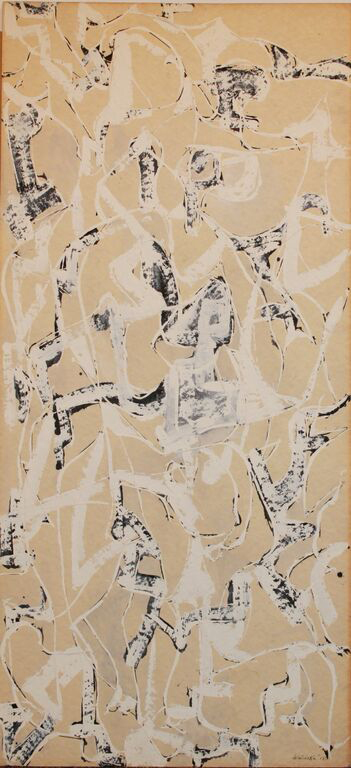
"Sacrifice of Isaac #3" by Anna Walinska, 1955-56. Casein on paper, 44.75 x 20.875 inches.
.
The centerpiece of the exhibition, Cityscape (1952), which can be absorbed thankfully without glass over it, is painted on nubby linen, the interstices of which fill with patterns of white paint circling little studs of grey, like the mother-of-pearl disks of a pair of cufflinks. A concentration of architectural forms at the center is built in firm black outlines: remember her niece’s admonition that this is an artist of line and its calligraphic potential as much as color. Creamy whites warmed by pinks and lavender echo the black lines in parallels that enhance their three-dimensional effect.
.

"Cityscape" by Anna Walinska, 1952. Oil on canvas, 18 x 24 inches.
.
There in the lower right is the Cubist moment, an angled rhombus heading toward the center of the painting. This element is a reminder that the faceted formal language of Cubism haunts many Abstract Expressionist paintings (look for it in Hans Hofmann and de Kooning, for example) just as the figure lingers beyond its dismissal in the push to abstraction.
Although the black and white palette immediately raises references to Franz Kline, Robert Motherwell or Adolph Gottlieb, the delicacy of Walinska’s whiplash curves, strange alphabets and scrubbed squares is too Mozartean to be confused with Kline’s pounding octaves, pure Beethoven.
Walinska had a way with greys as well, pearlescent and interrupted or tinged with yellows or lavenders, cut with streaks of white like the Chinese fei bai (flying white) stroke. In the bold vertical work, The Naked and the Dead (1956), the greys mingle with mustard yellows and browns. Forms descend in a swinging gestural motion like leaves rocking to the ground.
.
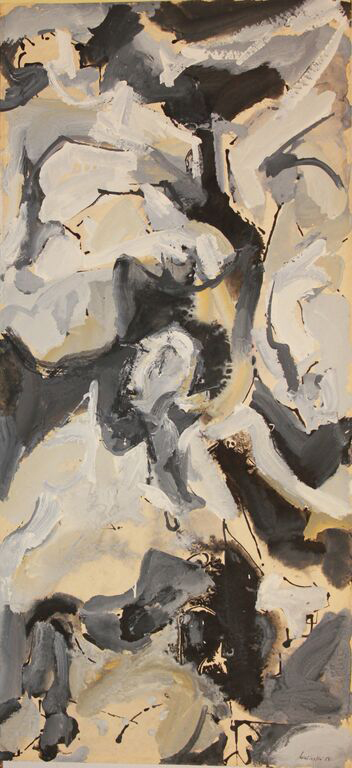
"The Naked & the Dead" by Anna Walinska, 1956. Casein on paper, 44.75 x 20.75 inches.
.
I turned the painting over to have a look at the label and let out an involuntary gasp. There by the title was another title, “Holocaust,” reminding me of the series the artist committed to an impossible aesthetic task. Returning to the central, almost figural form in the work, its contraposto exposing a skeletal armature that reminded me not only of the macabre Giacometti floor sculpture often called The Rape but of the large grisaille anti-war statement Picasso painted in June and July of 1945, The Charnel House. Nobody’s favorite Picasso, it takes its place by Guernica and the War and Peace murals as raw emotional response to history’s barbarism.
Easily forgotten in the dominant graphic impact of its twisted figures are the thin black lines tracing the crypt’s architecture in the background. They wend their way into Walinska’s black and white paintings, and it is tempting to conjecture about the possibility of her deliberately quoting the giant with whom she took coffee one day in the ’20s.
_____________________________
BASIC FACTS: "Anna Walinska" remains on view through September 8 at Lawrence Fine Art, 37 Newtown Lane (in the passageway), East Hampton, NY 11937. www.lawrence-fine-arts.com.
_____________________________
Copyright 2015 Hamptons Art Hub LLC. All rights reserved.

Her niece is the unsung hero of the show – no artist could have a more conscientious heir